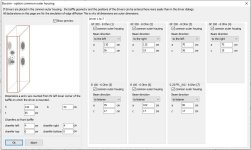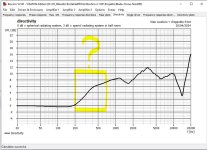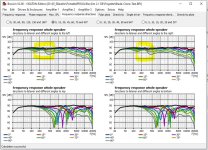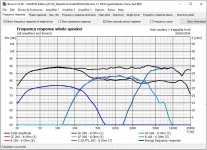Just me thinking out loud: If anyone wanted a cardioid response , couldn't they place any speaker behind their main and feed it out of phase, filtered programme? Fiddle with delays in bands of frequencies, the overall EQ curve etc .. A spare mid woofer in a cabinet.
Would be similar to what folks do in the PA world with their simulation software.
Less coloured sound but serious Localization & Integration issues?
Well the die-hard cardiotics are still dancing around their golden calf 🙂
You can't have it all .. no free lunch!
If you want to get a very narrow band cardioid response at quite low frequencies, yes you can. If you want midrange cardioid or a wider range of frequencies affected, no the distance between sources is too much.Just me thinking out loud: If anyone wanted a cardioid response , couldn't they place any speaker behind their main and feed it out of phase, filtered programme? Fiddle with delays in bands of frequencies, the overall EQ curve etc .. A spare mid woofer in a cabinet.
On the topic of cardioid……I’ve used it extensively in live installations and touring……keeps the low end from building on the performance stage where it pollutes the microphones, stage volume and induces low end feedback. At home, the only need for such low end directivity has been in the nearfield for monitoring, creating that same headphone experience only outside of my head…….it allows me to work quicker and make better decisions first time around.
Other than that, for home recreational use…..I don’t see a place where it’s practical.….. nor desirable from a subjective standpoint. What 3 identical subs and one additional out of phase can do with DSP is astonishing.…..I suggest it here as often as I can for those who are non believers. Fans of orchestral music take note….THIS is how you bring the concert hall into your space.
Other than that, for home recreational use…..I don’t see a place where it’s practical.….. nor desirable from a subjective standpoint. What 3 identical subs and one additional out of phase can do with DSP is astonishing.…..I suggest it here as often as I can for those who are non believers. Fans of orchestral music take note….THIS is how you bring the concert hall into your space.
Cardioid in the low bass, say below 100Hz where a separate sub operates is not really the point for home use (indeed it is very inefficient), rather maintaining directionality from the baffle step frequency down to about 100Hz is very beneficial, keeping RT60 lower in that difficult to treat range. I think of it as having a virtual wide baffle speaker without the practical issues of a 1m wide speaker.
P.S. I'm not convinced the benefit of cardioid is the ability to place a speaker close to the front wall. The more of your room that is placed behind a cardioid speaker, the less your room is being driven for the same SPL at the listening position.
P.S. I'm not convinced the benefit of cardioid is the ability to place a speaker close to the front wall. The more of your room that is placed behind a cardioid speaker, the less your room is being driven for the same SPL at the listening position.
On the topic of cardioid……I’ve used it extensively in live installations and touring……keeps the low end from building on the performance stage where it pollutes the microphones, stage volume and induces low end feedback. At home, the only need for such low end directivity has been in the nearfield for monitoring, creating that same headphone experience only outside of my head…….it allows me to work quicker and make better decisions first time around.
Other than that, for home recreational use…..I don’t see a place where it’s practical.….. nor desirable from a subjective standpoint. What 3 identical subs and one additional out of phase can do with DSP is astonishing.…..I suggest it here as often as I can for those who are non believers. Fans of orchestral music take note….THIS is how you bring the concert hall into your space.
Do you mind expanding on the 4 subs arrangment?
One use for it could be to prevent feedback from a turntable, set behind the speakers ?
On the topic of cardioid……I’ve used it extensively in live installations and touring……keeps the low end from building on the performance stage where it pollutes the microphones, stage volume and induces low end feedback. At home, the only need for such low end directivity has been in the nearfield for monitoring, creating that same headphone experience only outside of my head…….it allows me to work quicker and make better decisions first time around.
Other than that, for home recreational use…..I don’t see a place where it’s practical.….. nor desirable from a subjective standpoint. What 3 identical subs and one additional out of phase can do with DSP is astonishing.…..I suggest it here as often as I can for those who are non believers. Fans of orchestral music take note….THIS is how you bring the concert hall into your space.
I'm not familiar with this, have any links?
I'm familiar with the Geddes multisub approach, but haven't heard of using four and inverting one.
https://www.audiokinesis.com/the-swarm-subwoofer-system-1.html
Audiokinesis introduced a retail system/solution around a decade ago building on the work of Geddes and Harmon. I don‘t know how robust the DSP was back then or if they’re since improved it. The single out of phase sub is optional and works in some rooms better than others……..it would be dependent on placement limitations of room volume of course…..each situation will be unique. My personal experience is that I’ve always experienced a benefit from the single out of phase combined with 3 in phase.
Now if one were to combine say a 2x4 DSP with four independent subs each with their own plate amp equipped with variable phase control…..well…..the potential would be limitless……lots of wiring as well but in the struggle and strife for perfection?
Audiokinesis introduced a retail system/solution around a decade ago building on the work of Geddes and Harmon. I don‘t know how robust the DSP was back then or if they’re since improved it. The single out of phase sub is optional and works in some rooms better than others……..it would be dependent on placement limitations of room volume of course…..each situation will be unique. My personal experience is that I’ve always experienced a benefit from the single out of phase combined with 3 in phase.
Now if one were to combine say a 2x4 DSP with four independent subs each with their own plate amp equipped with variable phase control…..well…..the potential would be limitless……lots of wiring as well but in the struggle and strife for perfection?
Multisubs and cardioid don't conflict. Multisubs for 100Hz down combined with cardioid for 100 hz up works. If you've got a dedicated room with multisubs, you are probably free of space and placement constraints that would otherwise lead you towards cardioid to complete the solution. If on the other hand, you are footprint and placement constrained, cardioid from 100 hz up might be just what you need.
there is a free mult-sub optimizer will help you get the most of your subs, i.e. generate optimal filters for that 2x4 DSP:
multisub optimizer link
there is a free mult-sub optimizer will help you get the most of your subs, i.e. generate optimal filters for that 2x4 DSP:
multisub optimizer link
Youtube threw me up a comparison video between The Blade 2 Meta and Reference 3 Meta. Quite different tonalities.
It's all an empty talk if you can't listen for yourself. Original Blade was a dog for robots listening to hip -hop enjoying the Manhattan view from glass filled apartments. Kef is a company which lost its way ages ago
That’s the challenge right there.You are unlikely to find any loudspeaker thaty has perfect anything.
dave
Close to the blade or perfect speaker ?
If you want a proof that aliens are already among us dehumanizing population you don't need a further evidence They hijacked hi-fi industry and Kef was one of the first victims.
If you want a proof that aliens are already among us dehumanizing population you don't need a further evidence They hijacked hi-fi industry and Kef was one of the first victims.
It's all an empty talk if you can't listen for yourself. Original Blade was a dog for robots listening to hip -hop enjoying the Manhattan view from glass filled apartments. Kef is a company which lost its way ages ago
Sounds like the perfect speaker for Patrick Bateman....
Remember the stampede to buy that LS50 cr...p? It was sold in every butcher shop and from used cars saloons by the perfectly qualified for the task sales persons usually working in those places. Kef Blade auditioned at the same time sounded somewhat worse than those little pieces of shi..te
it costs you about 6db where excursion limited, (which wouldn't be the case if limited to 500 Hz up) but you can get that back in the system design if you feel you need it
D&D 8C reviews show and Geddes has been saying for years that a little bit of THD doesn't really matter
so too with Sigberg Audio cardioid coax's
but I think if you are cardioid only down to 500 Hz, that directivity change where you cross to woofers may be problematic
The cardioid implementation in the Sigberg Audio Manta does not have any meaningful loss of capacity / increase in THD. 🙂
Funny how the topic is being offset with the Cardioid discussion……i didn’t think about it so much in that I ‘assumed’ big speakers…..big room…. If I were considering a compact environmental system, I’d not hesitate for a pair of LS50s and a quad of 8” subs with a full DSP cross and tune.
Hi all,
i am no good with VituixCAD but very quick with Visaton's BoxSim
simulating real quick something similar like the Blade construction like this



i can see that there might be issue with the directivity changes between 200 and 500 Hz and with the frequency response directions that you will not get with front mounted woofers
So far - so good, Stefano
P.S.: for correctness also the on axis estimated frequency response
active crossover
LR4 330 / 270 Hz woofer to midrange and PEQ 30 Hz / Q=1 / A=6db for CB enclosure bass EQ for free field simulation
LR4 3300 / 4300 Hz midrange to dome with waveguide

i am no good with VituixCAD but very quick with Visaton's BoxSim
simulating real quick something similar like the Blade construction like this



i can see that there might be issue with the directivity changes between 200 and 500 Hz and with the frequency response directions that you will not get with front mounted woofers
So far - so good, Stefano
P.S.: for correctness also the on axis estimated frequency response
active crossover
LR4 330 / 270 Hz woofer to midrange and PEQ 30 Hz / Q=1 / A=6db for CB enclosure bass EQ for free field simulation
LR4 3300 / 4300 Hz midrange to dome with waveguide

Last edited:
- Home
- Loudspeakers
- Multi-Way
- KEF Blade 2 meta vs Reference 5 meta?…..which is better?